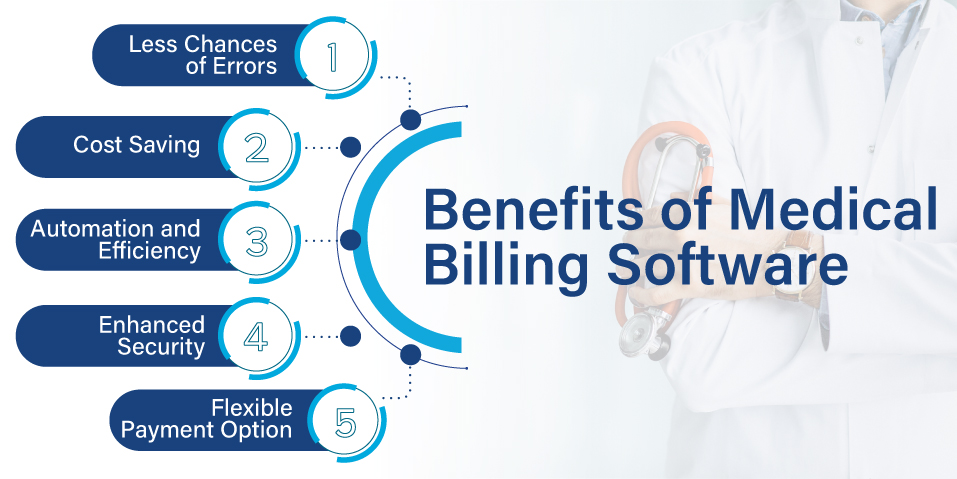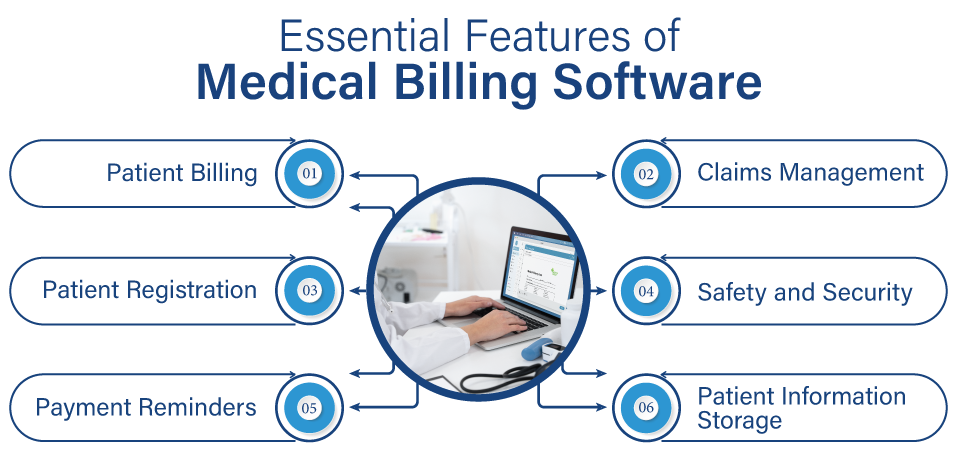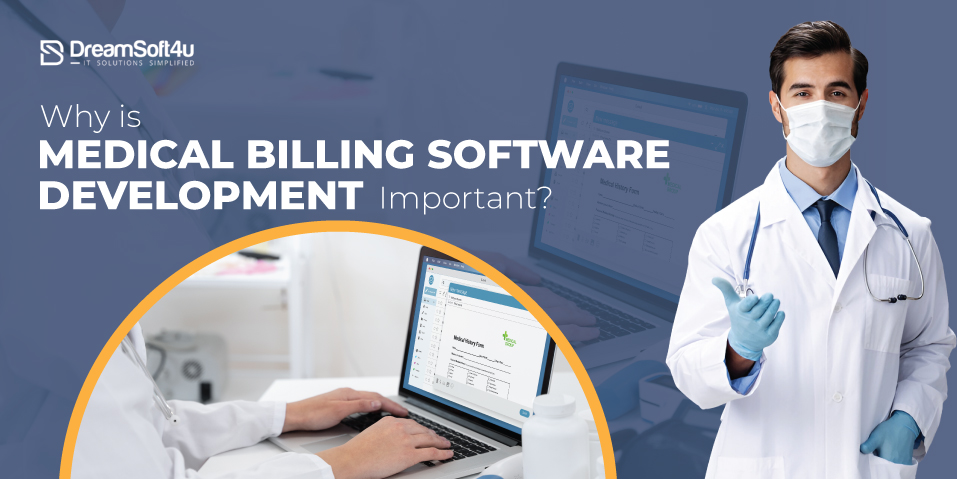With the world taking the path of digitization in the healthcare industry, one thing that remains the same is the need for accurate medical billing; that’s when medical billing software solutions are preferred. As a result, the medical billing software market is expected to experience a CAGR of 12% between 2022 to 2029.
Thus, integrating healthcare organization and medical billing software promises a hassle-free billing process and an excellent payment gateway. If you still believe there is no need for this software development, you have landed on the right page. This article is a complete guide about medical billing software, its benefits, essential features, importance, and more. So, without any further delay, let’s dive in!
Table of Contents
ToggleWhat is Medical Billing Software?
In simple terms, medical billing software is designed and developed to automate healthcare invoicing and optimize business management solutions effectively. This software allows billing and medical practice companies to improve reimbursement rates, update patient information, and optimize revenue.
Since this software is fully integrated with EHRs and technology-driven, there are fewer chances of human errors, and it displays fetched data in a better manner. Healthcare facilities like clinics, hospitals, and wellness centers generally use this software to manage everyday communications and submit claims. Also, it is used to track payments and manage billing.
Benefits of Medical Billing Software
Here are the top benefits:

1. Less chances of errors
Advanced software ensures there are fewer chances of errors in patient claims. This software uses coding practices to offer healthcare experts accurate reimbursements based on information from various sources like procedures and medical reports. Since medical billing software does not have human interference, the chances of risks are lesser, ensuring everything remains on track and runs smoothly.
2. Cost saving
Although integrating medical billing software is a huge investment, it can save much money in the long run by minimizing billing errors, reducing administrative workload, and optimizing revenue collection.
3. Automation and efficiency
Since this software automates reimbursement procedures and bill claims, it optimizes operational efficiencies. This software automates everyday tasks, saves time, and minimizes the scope of human errors. This includes generating claims submission, payment posting, and invoices, streamlining the entire billing cycle effectively.
4. Enhanced security
This software has highly advanced security features to protect patient’s personal or sensitive information. The patient’s personal information remains protected and confidential since compliance with the Health Insurance Portability and Accountability Act or HIPAA.
5. Flexible payment option
Healthcare experts seamlessly integrate the software for medical coding with a wide range of payment options for easy payment settlement. It enhances the patient’s experience and accelerates the payment cycle. Additionally, the time wasted between offering services and making payments is eliminated.
Essential Features of Medical Billing Software
Here are some important features of the software for medical coding:

1. Patient billing
Patient billing is the most important feature of the software as it tracks payment, stores payment history, generates invoices and collects all important information about the billing. This software allows providers to pay faster, improve overall workflow, and keep the patent updated. Additionally, it eliminates paper usage in the medical industry and smoothens the workflow for different processes; ultimately, it improves user experience.
2. Claims management
Integrating the software, there is no need to dedicate a large group of people to verify different insurance coverages and claims. This also includes scheduled and walk-in patients who visit the healthcare center and wait until their insurance is thoroughly checked. Since this software verifies insurance automatically, it prioritizes patient care, speeds up the admission process, and decreases the denial rate. Additionally, all errors and inaccuracies can be identified clearly in claim documents.
3. Patient registration
Another must-have feature of it is patient registration, which enhances the onboarding and intake process of the medical industry. Complex data collection and administrative tasks result in less work done; thus, you can collect patient’s data beforehand, making it easier to organize the data and offer excellent services to all patients. Patient registration includes important information like payment history, eligibility, and medical benefit checks.
4. Safety and security
Protecting your data is extremely important in the healthcare industry as it includes sensitive and personal information of patients. Healthcare Insurance Portability and Accountability Act or HIPAA promises complete security of ePHI by implementing physical, administrative, and technical safeguards on healthcare providers, entities, or organizations. This data is protected through End-to-end data encryption and firewalls, minimizing the chances of fraud and cyberattacks.
5. Payment reminders
Making timely payments is one of the major responsibilities of all patients. Medical healthcare centers can now send payment reminders using the billing software, which informs the patient about the delay in the payment and makes it timely. Medical billing systems generate an automated message with CTAs like “Pay Now,” which allows the patient to make the payment in real-time. Since payment reminders regularly alert the patient regarding the payment, it eliminates the chances of shocks while looking at the bill.
6. Patient information storage
Keeping a record of all patient’s personal information like name, sex, age, medical problems, allergies, and more saves a lot of crucial time, resulting in a better experience. It allows the medical staff to indulge in more complex tasks than calling every patient and asking for their details. Once the information is collected, it will remain stored forever. Also, this software follows robust security channels, minimizing any chances of data breaches.
How to Develop a Medical Billing Software? (Steps)
Here is the step-by-step process of software development:
1. Define Requirements and Objectives
Understand the needs of medical experts or healthcare providers based on factors such as compliance needs, specialties, and more. Define a clear software development objective like improving revenue management, reducing errors, streamlining the billing process, etc.
2. Research and Planning
Once the requirements and objectives are defined clearly, it’s time to dive into actual research and planning. Analyze different medical billing and coding software available in the market and conduct deep research to understand their strengths and weaknesses. Also, analyze the competitive landscape. Create a well-organized and comprehensive plan with all vital information like budget, resources available, timeline, and milestones.
3. Design and Architecture
Start designing a software structure while considering the data flow, security, scalability, and integration capabilities. Additionally, designed and developed a highly advanced, user-friendly, and intuitive interface for quick navigation and excellent workflow. This is where you need to hire a custom software development company where professionals can design as per your requirements and vision.
4. Development
It’s time for the actual development of the medical billing software. Development will be classified into three parts: backend, frontend, and coding and testing. Start by building core functionalities like billing process, patient data management, integration with different systems, and claims management. Based on the selected design, develop the user interface, ensuring it meets users’ requirements and improves end-user experience. You must write clear and clean codes and conduct a strict testing process to reveal and fix bugs at every stage.
5. Integrations and Compliance
Conduct a hassle-free integration with practice management systems, third-party APIs, and electronic healthcare records. To meet the safety and security standards to ensure patient’s personal information remains protected, follow all healthcare rules and regulations like HIPAA.
6. Quality Assurance (QA)
Conducting continuous and comprehensive tests to ensure the software works well is vital for quality assurance. If any issues are discovered during the testing stage, address these bugs and find solutions for optimal performance.
7. Monitoring and Maintenance
Taking continuous user feedback and monitoring the medical billing and coding software to analyze any existing issues is important. The software must be updated regularly for enchantments and to incorporate new features.
Cost of Developing Medical Billing Software
The cost of developing software is different for all as several factors determine the over cost. These include functionalities, features, project duration, legal formalities, etc. Here is an estimated cost of developing a medical billing software:
1. Pre-development Tasks cost between $6000 for more than 100 hours
2. Core Feature Development costs between $6500 – $10,000 for 100 to 150 hours
3. Custom Feature Development costs between $16,000 – $20,000 for more than 270 to 400 hours.
Challenges With the Medical Billing System
Some challenges with the medical billing system include:
1. Coding complexities
To develop highly instituted medical billing software, the developer needs to write highly proficient and clean codes, which tend to evolve continuously. Staying updated with all the latest changes and ensuring all written codes are accurate is a big challenge for medical coding software.
2. Rejected or denied claims
At times, minor errors in the claims result in untimely rejections or denial of claims, which stretches the revenue cycles. Analyzing and identifying these recurring problems is a time-consuming process that requires time, energy, and resources.
3. Missing financial analytics
Like most businesses worldwide, the healthcare sector also relies on financial analytics to determine what’s going on the right track. Through the lab billing application, it becomes easier to check the lab’s financial state. Big labs require larger financial analytics capabilities, which evolves as a challenge for this software.
4. Billing inefficiencies and errors
Making data entry manually results in errors and inaccuracies. Identifying and correcting the underlying errors takes a lot of your time and effort, resulting in dissatisfaction amongst your patients.
Wrapping Up!
The medical industry is experiencing a major digital transformation. Integrating medical billing software systems into the medical industry is an excellent choice. It will optimize and streamline the overall billing process. You can get in touch with DreamSoft4U, a leading HIPAA-compliant telemedicine solution provider. We have professionals who can develop the industry’s best medical billing software. Get in touch with experts and explore our types of medical billing software services today!
FAQs
1. What is the main purpose of medical billing software development?
Medical billing software development’s main purpose and integration into the healthcare industry is to optimize and streamline the chaotic billing process and simplify it within healthcare organizations. This software lets patients understand all charges, access their bills, and make payments in real time.
2. What is the need for medical billing software in a hospital?
There are several reasons why medical billing systems are essential in a hospital. These include:
- Efficiency and time-saving
- Improved accuracy and reduced errors
- Validate insurance coverage
- Removes any chances of manual errors
- Store all documents and patient’s information securely
- Provides timely notifications and alerts
- Enhanced Revenue Cycle Management
- Detailed analytics and reporting
3. What are the different types of medical billing software?
Three major types of medical billing software included:
- Closed Medical Billing Systems
- Open Medical Billing Systems
- Isolated Medical Billing Systems
4. List the components of a medical billing software
Some major components of software include claims management, business intelligence elements, constant compliance, automated scheduling, and real-time financial reporting
5. Are there any disadvantages to medical billing software in the medical industry?
Some significant disadvantages of using this software in the medical industry include complexity and learning curve, this software is expensive, the software can cause bugs, compatibility problems, or glitches, security concerns are present, dependency on technology is high, customization challenges always exist, updates and support services are important.
6. What is the overall cost of developing medical coding software?
When you hire software developers then there are many factors that affect the overall development cost of the software. On an average, the cost varies from:
a. Pre-development Tasks cost between $6000 for more than 100 hours
b. Core Feature Development costs between $6500 – $10,000 for 100 to 150 hours
c. Custom Feature Development costs between $16,000 – $20,000 for more than 270 to 400 hours.























